USS Missouri (BB-63)
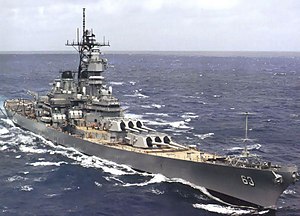 Missouri at sea in her 1980s configuration
| |
| History | |
|---|---|
| Namesake | State of Missouri |
| Ordered | 12 June 1940 |
| Builder | Brooklyn Navy Yard |
| Laid down | 6 January 1941 |
| Launched | 29 January 1944 |
| Sponsored by | Margaret Truman |
| Commissioned | 11 June 1944 |
| Decommissioned | 26 February 1955 |
| Identification | Hull number: BB-63 |
| Recommissioned | 10 May 1986 |
| Decommissioned | 31 March 1992 |
| Stricken | 12 January 1995 |
| Motto | "Strength for Freedom"[1] |
| Nickname(s) | "Mighty Mo"[1] |
| Status | Museum ship in Pearl Harbor |
| Badge |  |
| General characteristics (as built) | |
| Class and type | Iowa-class battleship |
| Displacement | 57,540 full load ) |
| Length | 887 ft 3 in (270.4 m) ( o/a ) |
| Beam | 108 ft 2 in (33 m) |
| Draft | 37 ft 9 in (11.5 m) |
| Installed power |
|
| Propulsion |
|
| Speed | 32.5 knots (60.2 km/h; 37.4 mph) |
| Range | 15,000 nmi (28,000 km; 17,000 mi) at 15 knots (28 km/h; 17 mph) |
| Complement | 117 officers, 1,804 enlisted men (designed) |
| Sensors and processing systems |
|
| Armament |
|
| Armor |
|
| General characteristics (1986) | |
| Complement | 1,515 officers and enlisted men |
| Sensors and processing systems | |
| Electronic warfare & decoys |
|
| Armament |
|
USS Missouri (BB-63) | |
| Location | Pearl Harbor, Hawaii |
| Coordinates | 21°21′44″N 157°57′12″W / 21.36222°N 157.95333°W |
| Built | 1944 |
| NRHP reference No. | 71000877 |
| Added to NRHP | 14 May 1971 |
USS Missouri (BB-63) is an Iowa-class battleship built for the United States Navy (USN) in the 1940s and is currently a museum ship. Completed in 1944, she is the last battleship commissioned by the United States. The ship was assigned to the Pacific Theater during World War II, where she participated in the Battles of Iwo Jima and Okinawa and shelled the Japanese home islands. Her quarterdeck was the site of the surrender of the Empire of Japan, which ended World War II.
After World War II, Missouri served in various diplomatic,
Missouri was
Missouri was again decommissioned in 1992, but remained on the Naval Vessel Register until her name was struck in 1995. In 1998, she was donated to the USS Missouri Memorial Association and became a museum ship at Pearl Harbor, Hawaii.
Background and description
The Iowa class of
Missouri is 887 feet 3 inches (270.4 m)
Armament, fire control, sensors and aircraft
The
The primary means of controlling the main armament are two Mark 38
A
The Iowas were built with two rotating aircraft catapults on their stern for floatplanes and a large crane was fitted to recover them. Initially a trio of Vought OS2U Kingfishers were carried, but these were replaced by Curtiss SC Seahawks in December 1944.[10][11][12]
Protection
The internal waterline
The main-gun turrets has Class B plates 19.5 in (495 mm) thick on their faces and 9.5 in (241 mm) of Class A plates on their sides. The armor plates protecting their barbettes range in thickness from 17.3 in (439 mm) to 14.8 in (376 mm) and 11.6 in (295 mm) with the thickest plates on the sides and the thinnest ones on the front and back. The sides of the conning tower are 17.3 in (440 mm) thick. The main deck of the Iowas consists of 1.5 in (38 mm) of STS. Below this deck, the roof of the armored citadel is formed by 6 in (152 mm) of armor in two layers. Below this is a deck of 0.625-inch (16 mm) STS plates intended to stop splinters from shells that pierced the armored deck above it. The armor deck extends aft and the roof of the steering gear compartment is 6.2 in (160 mm) thick.[14]
The
History
Construction
Missouri was the third ship of the United States Navy to be named after the
Missouri conducted her initial sea trials off New York, beginning on 10 July, and then steamed south to Chesapeake Bay, where she embarked on a shakedown cruise and conducted training. During this period, she operated with the new large cruiser Alaska, which had also recently entered service, and several escorting destroyers. The ship got underway on 11 November, bound for the West Coast of the United States. She passed through the Panama Canal a week later and continued on to San Francisco. There, additional fitting-out work was carried out at Hunters Point Naval Shipyard to prepare the vessel for use as a fleet flagship.[20]
World War II (1944–1945)

On 14 December, Missouri departed San Francisco and sailed for
By 16 February, the task force had arrived off the coast of Japan to begin a series of airstrikes. The fleet then proceeded to Iwo Jima, which was invaded by American ground forces on 19 February. That evening, while patrolling with the carriers, Missouri shot down a Japanese aircraft, probably a Nakajima Ki-49 bomber. Task Force 58 departed in early March and returned to Ulithi to replenish fuel and ammunition. Missouri was transferred to the Yorktown task group, TG 58.4 at that time.[23]
The ships departed again on 14 March for another round of air strikes on Japan.

While operating with the carriers on 11 April, Missouri came under attack from a kamikaze that struck the side of the vessel below the main deck. The impact shattered the aircraft, throwing gasoline on the deck that rapidly ignited, but it was quickly suppressed by her crew. The attack caused superficial damage and the battleship remained on station. Two crewmen were wounded on 17 April when another kamikaze clipped the stern crane and crashed in the ship's wake.[27] Missouri left Task Force 58 on 5 May to return to Ulithi; in the course of her operations off Okinawa, she claimed five aircraft shot down and another probable kill, along with partial credit for another six aircraft destroyed.[16] While en route, Missouri refueled from a fleet oiler that also brought the ship's new commander, Captain Stuart S. Murray, who relieved Captain Callaghan on 14 May.[28]
On 9 May, Missouri reached Ulithi, before continuing on to
Third Fleet got underway again on 1 July to launch another series of attacks on the Japanese
Signing of the Japanese Instrument of Surrender
Over the course of the following two weeks, Allied forces made preparations to begin the occupation of Japan. On 21 August, Missouri sent a contingent of 200 officers and men to Iowa, which was to debark a landing party in Tokyo to begin the process of demilitarizing Japan. Two days later, Murray was informed that Missouri would host the surrender ceremony, with the date scheduled for 31 August. The ship's crew immediately began preparations for the event, including cleaning and painting the vessel. Missouri began the approach to Tokyo Bay on 27 August, guided by the Hatsuzakura. That night, the ships stopped at Kamakura, where a courier brought the flag that Commodore Matthew Perry had flown during his expedition to open Japan in 1853; the flag was to be displayed during the surrender ceremony. The flotilla then entered Tokyo Bay on 29 August, and Missouri was anchored close to where Perry had anchored his own vessels some ninety-two years earlier. Poor weather delayed the ceremony until 2 September.[31]
By 09:30 the Japanese emissaries had departed. In the afternoon of 5 September, Halsey transferred his flag to the battleship South Dakota, and early the next day Missouri departed Tokyo Bay. As part of the ongoing Operation Magic Carpet she received homeward-bound passengers at Guam, then sailed unescorted for Hawaii. She arrived at Pearl Harbor on 20 September and flew Admiral Nimitz's flag on the afternoon of 28 September for a reception.[16][35]
Post-war (1946–1950)
The next day, Missouri departed Pearl Harbor bound for the

After an overhaul in the
Missouri departed Istanbul on 9 April and entered

Missouri departed Piraeus on 26 April, touching at
Missouri arrived at
The Truman family boarded Missouri on 7 September 1947 to return to the United States and disembarked at Norfolk on 19 September. Her overhaul in New York, which lasted from 23 September to 10 March 1948
Throughout the latter half of the 1940s, the various service branches of the United States had been reducing their inventories from their World War II levels. For the Navy, this resulted in several vessels of various types being decommissioned and either sold for scrap or placed in one of the various

Captain William D. Brown assumed command of the battleship on 10 December while she was being overhauled.
After the subsequent Naval Board of Inquiry, Brown and three of his officers were court-martialled. Brown was relieved of command and his subordinates were reprimanded. Captain Harold Page Smith assumed command on 7 February as the Missouri's repairs were being completed. Having repaired morale aboard during his tenure as the ship was relegated to training duties in an effort to cut costs by Johnson, Page Smith was replaced by Captain Irving Duke on 19 April.[49]
Korean War (1950–1953)
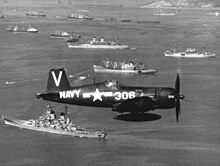
In 1950, the
Missouri arrived just west of
MacArthur's amphibious landings at Incheon had severed the
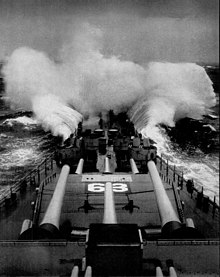
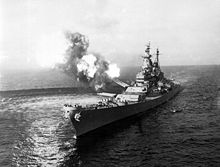
In early 1951 Missouri alternated carrier escort duty and shore bombardments off the east coast of Korea until 19 March.
Missouri spent the next six months training out of Guantanamo Bay and Norfolk and made a port visit to New York in May where she participated in Navy Day celebrations, hosting nearly 11,000 visitors.[59] She returned to Norfolk on 4 August and entered Norfolk Naval Shipyard to prepare for a second tour in the Korean combat zone.[16] Captain Warner Edsall relieved Sylvester at the beginning of the overhaul.[60] The battleship departed Hampton Roads on 11 September and arrived at Yokosuka on 17 October.[16]
Vice Admiral
Missouri arrived at Norfolk on 4 May; Rear Admiral E. T. Woolridge, commander, Battleships-Cruisers, Atlantic Fleet, hoisted his flag aboard her 10 days later. She departed on 8 June on a midshipman training cruise to Brazil, Cuba and Panama and returned to Norfolk on 4 August. Woolridge hauled down his flag in October as he transferred to another ship; Rear Admiral Clark Green, commander of Battleship Division 2 replaced him. The battleship was overhauled in Norfolk Naval Shipyard from 20 November to 2 April 1954 that included replacing her 16-inch guns
Deactivation
Missouri was moored at the last pier of the reserve fleet berthing. She served as a tourist attraction, logging about 250,000 visitors per year,[73] who came to view the "surrender deck" where a bronze plaque memorialized the spot (35°21′17″N 139°45′36″E / 35.3547°N 139.76°E) in Tokyo Bay where Japan surrendered to the Allies. The accompanying historical display included copies of the surrender documents and photos.[70] Nearly thirty years passed before Missouri returned to active duty.[71]
Reactivation (1984–1990)
Under the
Over the next several months, the ship had her obsolete armament removed: 20 mm and 40 mm AA guns, their directors, and four of her ten 5-inch gun mounts. Installed in their place on the superstructure were four Mk 141 quad cell launchers for 16
During the modernization the ship's 800 lb (360 kg) bell, which had been removed from the battleship and sent to Jefferson City, Missouri for sesquicentennial celebrations in the state, was formally returned to the battleship in advance of her recommissioning.[78] Missouri was formally recommissioned in San Francisco on 10 May 1986 with Captain Albert Kaiss in command. "This is a day to celebrate the rebirth of American sea power", Secretary of Defense Caspar Weinberger told an audience of 10,000 at the recommissioning ceremony, instructing the crew to "listen for the footsteps of those who have gone before you. They speak to you of honor and the importance of duty. They remind you of your own traditions."[79] Margaret Truman gave a short speech especially aimed at the ship's crew, which ended with "now take care of my baby." Her remarks were met with rounds of applause from the crew.[80]

Only briefly in command, Kaiss was relieved by Captain James A. Carney on 20 June.
In 1987, Missouri was outfitted with 40 mm
The ship returned to the United States via Diego Garcia, Australia, and Hawaii in early 1988. Captain John Chernesky relieved Carney on 6 July in Pearl Harbor during the biennial Rim of the Pacific (RimPac) exercises that had begun a few weeks earlier. Other highlights during the year included port visits in British Columbia and Washington.[84]
In the early months of 1989, Missouri was in the
Gulf War (January–February 1991)
On 2 August 1990
Missouri's scheduled four-month Western Pacific port-to-port cruise set to begin in September was canceled just a few days before the ship was to leave; after the cruise was completed, the ship was due to begin the process of inactivation. She had been placed on hold in anticipation of being mobilized as forces continued to mass in the Middle East. As part of the preparations for combat, a detachment of
On 29 January, the

During the campaign, Missouri was involved in a
During the operation, Missouri also assisted coalition forces engaged in clearing Iraqi naval mines in the Persian Gulf. By the time the war ended, the ship's crew had destroyed at least 15 naval mines.[90]
With combat operations out of range of the battleship's weapons on 26 February, Missouri had fired a total of 783 sixteen-inch shells and launched 28
Museum ship (1998 to present)
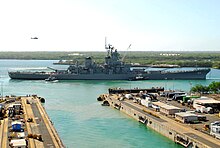
The collapse of the Soviet Union in the early 1990s and the absence of a perceived threat to the United States led to drastic cuts in the defense budget, and the high cost of maintaining and operating battleships as part of the United States Navy's active fleet became uneconomical. As a result Missouri was decommissioned on 31 March 1992 at Long Beach.[18] Her last commanding officer, Captain Albert L. Kaiss, wrote in the ship's final Plan of the Day:
Our final day has arrived. Today the final chapter in battleship Missouri's history will be written. It's often said that the crew makes the command. There is no truer statement ... for it's the crew of this great ship that made this a great command. You are a special breed of sailors and Marines and I am proud to have served with each and every one of you. To you who have made the painful journey of putting this great lady to sleep, I thank you. For you have had the toughest job. To put away a ship that has become as much a part of you as you are to her is a sad ending to a great tour. But take solace in this—you have lived up to the history of the ship and those who sailed her before us. We took her to war, performed magnificently and added another chapter in her history, standing side by side our forerunners in true naval tradition. God bless you all.
— Captain Albert L. Kaiss[79]
Missouri returned to be part of the

Originally, the decision to move Missouri to Pearl Harbor was met with some resistance. The National Park Service expressed concern that the battleship, whose name has become synonymous with the end of World War II, would overshadow the battleship Arizona, whose dramatic explosion and subsequent sinking on 7 December 1941 has since become synonymous with the attack on Pearl Harbor. To help guard against this impression Missouri was placed well back from and facing the Arizona Memorial, so that those participating in military ceremonies on Missouri's aft decks would not have sight of the Arizona Memorial. The decision to have Missouri's bow face the Arizona Memorial was intended to convey that Missouri watches over the remains of Arizona so that those interred within Arizona's hull may rest in peace.[101]
Missouri was listed on the National Register of Historic Places on 14 May 1971 for hosting the signing of the instrument of Japanese surrender that ended World War II.[101] She is not eligible for designation as a National Historic Landmark because she was extensively modernized in the years following the surrender.[102]
On 14 October 2009, Missouri was moved from her berthing station on Battleship Row to a
Awards
Missouri earned three
| 1st row | Combat Action Ribbon | Navy Unit Commendation | |||||
|---|---|---|---|---|---|---|---|
| 2nd row | Meritorious Unit Commendation | Battle E device
|
China Service Medal |
|---|---|---|---|
| 3rd row | American Campaign Medal | Asiatic-Pacific Campaign Medal with three campaign stars
|
World War II Victory Medal |
| 4th row | Navy Occupation Service Medal | National Defense Service Medal with service star | Korean Service Medal with silver service star (5 campaigns) |
| 5th row | Armed Forces Expeditionary Medal | Southwest Asia Service Medal with two campaign stars | Sea Service Deployment Ribbon with two service stars
|
| 6th row | Republic of Korea Presidential Unit Citation
|
United Nations Service Medal
|
Liberation of Kuwait Medal |
Appearances in popular culture
The ship was central to the plot of the 1992 film Under Siege (many of the on-ship scenes were shot aboard the similar but older battleship USS Alabama). The ship was also prominently featured in the 2012 sci-fi action film Battleship. As Missouri has not moved under her own power since 1992, shots of the ship at sea were obtained with the help of three tugboats.[110]
See also
- List of broadsides of major World War II ships
- List of museum ships
- U.S. Navy memorials
- U.S. Navy museums(and other battleship museums)
Notes
- ^ /50 refers to the length of the gun in terms of calibers. A /50 gun is 50 times long as its bore diameter.
- ^ Another U.S. flag was raised and flown during the occasion, a flag that some sources have indicated was in fact that flag which had flown over the U.S. Capitol on 7 December 1941. This is not true; it was a flag taken from the ship's stock, according to Murray, and it was "...just a plain ordinary GI-issue flag".[34]
Citations
- ^ a b Price, Gary; Cliffe, Richard (19 June 1989). "The "Official" USS Missouri Survival Guide". Naval History and Heritage Command. USS Missouri's Public Affairs Office. Retrieved 23 March 2021.
- ^ Friedman 1980, p. 99.
- ^ Friedman 1985, pp. 306–307.
- ^ Sumrall, p. 157.
- ^ Friedman 1985, pp. 317, 319, 323, 449.
- ^ a b Sumrall, p. 159.
- ^ Friedman 1985, pp. 323, 449.
- ^ Sumrall, pp. 91–94, 98–100, 102–103.
- ^ Sumrall, pp. 109, 113.
- ^ Sumrall, pp. 94–95.
- ^ Draminski, p. 29.
- ^ Stillwell, p. 25.
- ^ Sumrall, pp. 128–129, 170–171.
- ^ Sumrall, pp. 129–130.
- ^ Sumrall, pp. 130, 132.
- ^ a b c d e f g h i j k l m n o p q r s t u v w x y z aa ab ac ad ae af ag DANFS.
- ^ Stillwell, p. 1.
- ^ a b "Missouri (BB 63)". Naval Vessel Register. United States Navy. 19 July 2002. Retrieved 3 December 2007.
- ^ Stillwell, pp. 1–11.
- ^ Stillwell, pp. 14–25.
- ^ Rohwer, p. 393.
- ^ Stillwell, p. 27.
- ^ Stillwell, pp. 28–30.
- ^ Rohwer, p. 399.
- ^ Rohwer, p. 402.
- ^ Rohwer, p. 408.
- ^ Stillwell, pp. 33–37.
- ^ Stillwell, pp. 37–38.
- ^ Rohwer, pp. 418–419.
- ^ Rohwer, pp. 421–422.
- ^ Stillwell, pp. 50–51, 53–57.
- ^ Stillwell, p. 65.
- ^ "Missouri's place in history". All Hands. No. 822. United States Navy. September 1985. p. 16.
- ^ Murray, Stuart S. "Reminiscences of the Surrender of Japan and the End of World War II". USS Missouri Memorial Association. Archived from the original on 26 October 2019. Retrieved 25 October 2019.
- ^ Stillwell, p. 78.
- ^ Stillwell, p. 86.
- ^ Stillwell, p. 356.
- ^ Sumrall, p. 92.
- ^ Stillwell, pp. 100–102.
- ^ Stillwell, p. 110.
- ^ Sumrall, pp. 101, 110–112.
- ^ Close, Robert A. (Cmdr). "Helo Operations". U.S. Naval Academy Alumni Association & Foundation. Archived from the original on 14 February 2012. Retrieved 25 October 2019.
- ^ Stillwell, p. 365.
- OCLC 30148811. Archived from the originalon 19 December 2007. Retrieved 3 December 2007.
- ^ Adamski, Mary (9 August 1998). "Mighty Mo anchors $500,000 donation". Honolulu Star-Bulletin. Retrieved 14 June 2007.
- ^ Stillwell, pp. 145–148.
- ^ Stillwell, pp. 153–157.
- ^ Butler, pp. 114–128.
- ^ Stillwell, pp. 160–164.
- ^ Stillwell, pp. 166–168.
- ^ Stillwell, pp. 171–172.
- ^ Stillwell, p. 178.
- The History Channel.
- OCLC 81433331.
- OCLC 8345640.
- ^ Stillwell, pp. 185, 389.
- ^ Stillwell, p. 187.
- ^ a b Stillwell, p. 389.
- ^ Stillwell, pp. 198–202.
- ^ Stillwell, p. 202.
- ^ Stillwell, pp. 206–207.
- ^ Stillwell, pp. 209–210.
- ^ Stillwell, pp. 211–212.
- ^ Stillwell, pp. 215–219.
- ^ Sumrall, p. 112.
- ^ Stillwell, pp. 219–221, 224–227, 389.
- ^ Kaplan, p. 166.
- ^ Stillwell, pp. 229–231.
- ^ Stillwell, pp. 232.
- ^ a b "Missouri Quiet Now 29 Years after War Ended". The Bulletin. Bend, Oregon. Associated Press. 2 September 1974. p. 7.
- ^ a b Stillwell, pp. 238–246.
- ^ Sumrall, p. 94.
- ^ a b Camden, Jim (13 March 1984). "Big Ship in Midst of Fight". Spokesman-Review. Spokane, Washington. p. A6.
- ^ Weissleder, Bob (November 1984). "Mighty Mo Rejoins Fleet". All Hands. No. 813. Alexandria, VA: United States Navy. pp. 26–28.
- ^ Stillwell, p. 393.
- ^ Sumrall, p. 143.
- ^ Sharpe 1991, p. 732.
- ^ "Missouri bell returned". All Hands. No. 822. Alexandria, VA: United States Navy. September 1985. p. 16.
- ^ a b c "USS Missouri (BB-63)". The Battleships. United States Navy Office of Information. 24 April 2000. Archived from the original on 7 December 2006. Retrieved 15 December 2006.
- ^ "USS Missouri". ABC News. 10 May 1986. Archived from the original on 7 July 2011. Retrieved 25 October 2019.
- ^ Poyer, Joe (1991). "Are These the Last Battleships?". In Lightbody, Andy; Blaine, Taylor (eds.). Battleships at War: America's Century Long Romance with the Big Guns of the Fleet. Canoga Park, California: Challenge Publications, Inc. pp. 50–53.
- ^ "Frequently asked questions aboard the Missouri". USS Missouri Memorial Association. 2004. Archived from the original on 16 October 2007. Retrieved 24 December 2006.
- ^ Chernesky, J. J. (October 1987). "Command History, Calendar Year 1987, (OPNAV Report Symbol 5750-1)". USS Missouri Memorial Association. p. 2. Archived from the original on 27 May 2003. Retrieved 24 December 2006.
- ^ Stillwell, pp. 382, 389.
- ^ Stillwell, pp. 296–298, 300, 389.
- ^ Stillwell, pp. 306–307.
- ^ Stillwell, pp. 306–314.
- OCLC 25081170. Archived from the originalon 5 December 2006. Retrieved 26 November 2006.
- ^ Stillwell, pp. 316, 319–324.
- ^ a b c d Kakesako, Gregg K. (15 June 1998). "Pride & Glory". Honolulu Star-Bulletin. Archived from the original on 20 March 2006. Retrieved 24 December 2006.
- ^ Stillwell, pp. 322–323.
- ^ Stillwell, p. 324.
- ^ Stillwell, p. 325.
- ^ "Lead Report #14246". Office of the Special Assistant for Gulf War Illnesses, Department of Defense. 23 January 1998. Archived from the original on 18 December 2007. Retrieved 3 December 2007.
- ^ Polmar, p. 129.
- ^ Stillwell, pp. 328–340.
- ^ "Battleship Photo Index BB-63 USS MISSOURI". www.navsource.org. Retrieved 15 March 2020.
- ^ Friedrich, Ed (4 May 2008). "Letting Go of the Mighty Mo". Kitsap Sun. Retrieved 6 May 2016.
- ^ Carr, Michael A. (9 May 2013). "Uss Missouri Memorial Association Inc - Nonprofit Explorer". ProPublica. Retrieved 12 November 2022.
- ^ Yamanaka, Sarah (18 January 2022). "Free admission to the Battleship Missouri Memorial on Jan. 29". Honolulu, Hawaii: Spectrum News. Retrieved 13 June 2022.
- ^ a b Kakesako, Gregg K. (15 October 1997). "Will "Mighty Mo" be too much?". Honolulu Star-Bulletin. Archived from the original on 18 November 2008. Retrieved 22 December 2006.
- ^ "USS Missouri". nps.gov. 25 August 2000. Retrieved 5 July 2022.
- ^ Nakaso, Dan (15 October 2009). "The Mighty Move". The Honolulu Advertiser. Retrieved 13 August 2012.
- Philadelphia Inquirer. Associated Press. 4 January 2010.
- ^ ""Mighty Mo" Superstructure Unveiled" (Press release). Battleship Missouri Memorial. 26 February 2018. Retrieved 16 May 2022.
- ^ "Missouri Ribbon Bar". 13 March 2004. Archived from the original on 13 March 2004. Retrieved 3 September 2023.
- ^ a b c Stillwell, pp. 294–295.
- ^ Stillwell, p. 294.
- ^ Stillwell, p. 295.
- ^ Wickman, Forest (21 May 2012). "Fact-Checking Battleship: Could We Really Revive the "Mighty Mo"?". Slate. Retrieved 23 February 2015.
Bibliography
- Butler, John (1995). Strike Able-Peter: The Stranding and Salvage of the USS Missouri. Annapolis, Maryland: Naval Institute Press. ISBN 1-55750-094-0.
- Draminski, Stefan (2020). The Battleship USS Iowa. Oxford, UK: Osprey Publishing. ISBN 978-1-4728-2729-6.
- ISBN 0-87021-715-1.
- Friedman, Norman (1980). "United States of America". In Chesneau, Roger (ed.). Conway's All the World's Fighting Ships 1922–1946. New York: Mayflower Books. pp. 86–166. ISBN 0-8317-0303-2.
- Kaplan, Philip (2004). Battleship. London: Aurum Press. ISBN 1-85410-902-2.
- "Missouri III (BB-63) 1944–1995". Dictionary of American Naval Fighting Ships. US Navy History and Heritage Command. 24 June 2019. Retrieved 3 August 2022.
- Man of War: Log of the United States Heavy Cruiser Louisville. The Dunlap Printing Co. 1946.
- ISBN 1-55750-656-6.
- ISBN 1-59114-119-2.
- Sharpe, Richard (1991). Jane's Fighting Ships 1991–92. London: Bulter & Tanner. ISBN 0-7106-0960-4.
- Stillwell, Paul (1996). Battleship Missouri: An Illustrated History. Annapolis, Maryland: Naval Institute Press. ISBN 1-55750-780-5.
- Sumrall, Robert F. (1988). Iowa Class Battleships: Their Design, Weapons, and Equipment. Annapolis, Maryland: Naval Institute Press. ISBN 0-87021-298-2.
Further reading
- Garzke, William H. & Dulin, Robert O. (1976). Battleships: United States Battleships in World War II. Annapolis: Naval Institute Press. ISBN 0-87021-099-8.
- Muir, Malcolm (1987). The Iowa Class Battleships. New York: Sterling Publishing Company. ISBN 0-8069-8338-8.
- Newell, Gordon. Mighty Mo: The Biography of the Last Battleship. Seattle: Superior Publishing Company. LCCN 72-87802.
- Reilly, John C. Jr. (1989). Operational Experience of Fast Battleships: World War II, Korea, Vietnam. Washington DC: Naval Historical Center. OCLC 19547740.
- ISBN 1-55750-184-X.
External links
- Battleship Missouri Memorial museum website
- Photo gallery at Naval Historical Center
- USS Missouri (BB-63) at Historic Naval Ships Association
- Photo gallery of USS Missouri at NavSource Naval History
- nvr.navy.mil: USS Missouri
- Historic American Engineering Record (HAER) No. HI-62, "USS Missouri, Battleship Row, Ford Island, Pearl City, Honolulu County, HI", 6 measured drawings, 21 data pages

